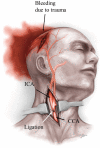History of Carotid Artery Reconstruction around the World and in Japan
- PMID: 37081650
- PMCID: PMC10406461
- DOI: 10.2176/jns-nmc.2022-0362
History of Carotid Artery Reconstruction around the World and in Japan
Abstract
Since ancient times, physicians have been aware of correlations between the carotid artery and consciousness; however, carotid stenosis was only recently identified as the cause of atherothrombotic ischemic stroke. In 1658, Wepfer described the first suggestion of a link between symptoms of cerebral arterial insufficiency and carotid pathology. In 1951, Fisher reported details of the symptoms and pathological findings and emphasized that cervical atheromatous lesions induced cerebral infarction with various symptoms. The beginning of carotid artery surgery was ligation of the carotid artery for neck or head injury, but surgeons were aware that this operation induced cerebral symptoms due to lack of blood supply. Carotid endarterectomy (CEA) was first reported by Eastcott et al. in 1954, and in Japan, Kimoto performed a successful CEA in 1962. In 1979, percutaneous transluminal angioplasty (PTA) was performed for patients with fibromuscular dysplasia, and then, carotid artery stenting (CAS) was first performed in 1989 by Mathias. In Japan, Kuwana et al. were the first to perform carotid PTA, in 1981, whereas Yamashita et al. performed the first CAS in 1997. Yoshimura et al. proposed staged carotid stenting to prevent hyperperfusion syndrome. Some issues in carotid reconstruction are still debated today, which include conventional (standard) CEA versus the eversion technique, CEA versus CAS versus medical therapy, and medical economic problems. In the future, we must continue to develop more effective, safer, and less expensive therapeutic methods to prevent carotid stroke, carrying on the efforts of the ancient peoples who pioneered this research.
Keywords: carotid endarterectomy; carotid ligation; history; surgical treatment.
Conflict of interest statement
The author has no conflicts of interest to declare regarding this study or its findings.
Figures



Similar articles
-
Long-Term Outcomes of Carotid Endarterectomy and Carotid Artery Stenting for Carotid Artery Stenosis: Real-World Status in Japan.J Stroke Cerebrovasc Dis. 2016 Feb;25(2):360-7. doi: 10.1016/j.jstrokecerebrovasdis.2015.10.007. Epub 2015 Nov 10. J Stroke Cerebrovasc Dis. 2016. PMID: 26564376
-
Carotid artery stenting versus endarterectomy for the treatment of both symptomatic and asymptomatic patients with carotid artery stenosis: 2 years' experience in a high-volume center.Adv Clin Exp Med. 2018 Dec;27(12):1691-1695. doi: 10.17219/acem/75902. Adv Clin Exp Med. 2018. PMID: 30063301
-
Endarterectomy or carotid artery stenting: the quest continues.Am J Surg. 2008 Feb;195(2):259-69. doi: 10.1016/j.amjsurg.2007.07.022. Am J Surg. 2008. PMID: 18154764 Review.
-
Differential outcomes of carotid stenting and endarterectomy performed exclusively by vascular surgeons in the Carotid Revascularization Endarterectomy versus Stenting Trial (CREST).J Vasc Surg. 2013 Feb;57(2):303-8. doi: 10.1016/j.jvs.2012.09.014. Epub 2012 Dec 20. J Vasc Surg. 2013. PMID: 23265585 Free PMC article. Clinical Trial.
-
Asymptomatic Carotid Artery Stenosis: Revascularization.Prog Cardiovasc Dis. 2017 May-Jun;59(6):591-600. doi: 10.1016/j.pcad.2017.04.006. Epub 2017 May 3. Prog Cardiovasc Dis. 2017. PMID: 28478115 Review.
Cited by
-
Clinical Significance of Carotid Endarterectomy and Carotid Artery Stenting in Older Patients Over 80.Neurol Med Chir (Tokyo). 2024 Apr 15;64(4):147-153. doi: 10.2176/jns-nmc.2023-0245. Epub 2024 Feb 26. Neurol Med Chir (Tokyo). 2024. PMID: 38403718 Free PMC article.
-
MicroNET-covered stent use to seal carotid artery perforation.Postepy Kardiol Interwencyjnej. 2023 Sep;19(3):284-288. doi: 10.5114/aic.2023.131483. Epub 2023 Sep 27. Postepy Kardiol Interwencyjnej. 2023. PMID: 37854974 Free PMC article. No abstract available.
-
Validity of E-PASS Score for Evaluating Perioperative Minor Complications Associated with Carotid Endarterectomy.Neurol Med Chir (Tokyo). 2025 Jan 15;65(1):9-14. doi: 10.2176/jns-nmc.2024-0035. Epub 2024 Nov 25. Neurol Med Chir (Tokyo). 2025. PMID: 39581620 Free PMC article.
-
Characteristics of highly cited articles in cerebral angiography.Neuroradiol J. 2025 Feb 26:19714009251324292. doi: 10.1177/19714009251324292. Online ahead of print. Neuroradiol J. 2025. PMID: 40009826 Free PMC article. Review.
References
-
- Cole TS, Mezher AW, Catapano JS, et al. : Nationwide trends in carotid endarterectomy and carotid artery stenting in the post-CREST era. Stroke 51: 579-587, 2020 - PubMed
-
- Munster AB, Thapar A, Davies AH: History of carotid stroke. Stroke 47: e66-e69, 2016 - PubMed
-
- Thompson JE: The evolution of surgery for the treatment and prevention of stroke. The Willis Lecture. Stroke 27: 1427-1434, 1996 - PubMed
-
- Min WD, Loftus CM: History of carotid surgery. Neurosurg Clin N Am 12: 167-172, 2001 - PubMed

